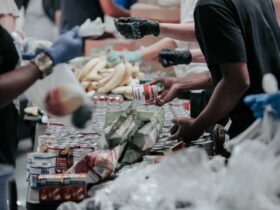Food insecurity is the situation when people lack secure access to sufficient amounts of safe and nutritious food needed for their normal growth and development, as well as for an active and healthy life. This is a big problem for many countries in the world and at the moment, the total number of food-insecure people hasn’t seen a decrease but the opposite.
How many people is food-insecure? Which countries have the most problems when it comes to food insecurity? These and many more questions we’ll cover in today’s article. Find out everything you need to know about this global problem.
3 Key Food Insecurity Statistics
- There is an increase in food-insecure people in low-income countries.
- Food insecurity has had a slow growth for the last 6 years.
- Somalia has 5.6 million people who are currently food insecure.
10 Food Insecurity Statistics
1. About 9% of the world population is severely food insecure.
According to the research made by Our World in Data, around 9% of the world population is severely food insecure. The percentage presents a high number of 697 million people around the globe. Some researchers estimate that this number will have a high increase in the upcoming years.
Source: Our World in Data
2. In 2021, 30.8% of the population is food insecure in low-income countries.
There has been an increase in the number of people in low-income countries who face food insecurity every single day. In 2020, the percentage of such people was 24%. This year, there was a 6.8% of increase for 56 out of 76 countries which were included in the research made by the USDA Economic Research Service. Asia and North Africa were the regions with the highest increase – 8.1% and 8.9% more food insecure population.


Source: USDA Economic Research Service
3. Nearly one in three people in the world didn’t have access to adequate food in 2020.
The year 2020 has put many challenges in front of people, due to conflicts, climate change, and the COVID-19 pandemic. Through the year, 2.37 billion people didn’t have access to adequate food. That number is increased by 320 million people from the previous year, which is quite a terrifying and high number of people who didn’t have food security.
Source: Food and Agriculture Organization of the United Nations
4. Food insecurity has been slowly climbing for the last 6 years.
Food insecurity, both moderate and severe, has had a slow but steady growth for the last 6 years. Due to that, it affects more than 30% of the world population who do not have secured food for their everyday life.
Source: Food and Agriculture Organization of the United Nations
5. The negative effects of COVID-19 are estimated to increase the number of food-insecure people.
The negative effects of COVID-19 definitely increase the number of food-insecure people. In 2021, the number was increased by around 291 million in 76 low and middle-income countries. It is estimated that such increases in food insecurity will be driven by Central and South Asian countries.
Source: USDA Economic Research Service
6. Around 16.2 million Yemenis are food-insecure.
According to the hunger rate in Yemen, the country has been declared the world’s largest food security crisis. The high number of Yemenis who are food-insecure have problems primarily because of the conflict.
Source: Concern Worldwide US
7. Around 1.9 million people in Madagascar are food insecure.
With almost half of the population fighting undernourishment, Madagascar is fighting a high rate of food insecurity. 1.9 million people are food insecure. That number includes 450,000 people who face chronic food insecurity.


Source: Concern Worldwide US
8. More than half of the population of the Central African Republic is food insecure.
The country has around 2.6 million people who are food insecure. That is 57% of the population. According to the data provided by ReliefWeb, 1 million people are classified as an emergency, and out of them, 250,000 are at a high risk of a catastrophic situation. Also, those people are largely inaccessible.
Source: ReliefWeb
9. Somalia is the hungriest country in the world in 2021.
Due to the study conducted by IFRC, The International Federation of Red Cross, Somalia has 5.6 million people who are currently food insecure. 2.8 million of the population cannot meet their daily food requirements. The main reasons for such a bad situation are drought, flooding, economic impacts caused by COVID-19, and conflict. Besides the mentioned, Somalia is the hungriest country in the world in 2021.
Source: IFRC
10. About 13.8 million US households were food insecure at some time during 2020.
The United States is also fighting the problems of food insecurities. During 2020, 10.5% of the US households, or in numbers, 13.8 million of them, at some point of the year were food insecure. The data from the USDA Economic Research Service shows that 6.6% or 8.6 million households had low food insecurity, while 3.9% of 5.1 million of them had very low food security.
Source: USDA Economic Research Service
To Wrap It Up
Climate change, COVID-19, conflict, and political situations are just a couple of main reasons for an increase of the food-insecure people in the world. And according to the predictions, the number will possibly increase in the upcoming years, especially due to the long-lasting effects of the pandemic. Food insecurity is just a step away from global hunger and all we can do is try and find a way to help the world with fighting these problems.


















Leave a Reply